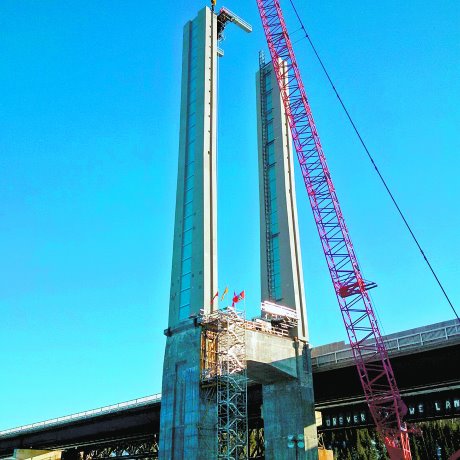It might be an overstatement to suggest that a new chapter in bridge construction in Ontario is occurring on Highway 11/17, otherwise known as the Trans-Canada Highway, about 100 kilometres northeast of Thunder Bay. But not by much.
Anyone who has driven from Ontario to Western Canada has had to cross the 1960s two-lane bridge over the Nipigon River on the outskirts off Nipigon.
By 2017 that structure will have been replaced with the first cable-stayed bridge ever built in the province.
Now well under construction, the new 252-metre-long (826-foot) 37-metre-wide, (121-foot) two-span, four-lane structure is one of series of Ministry of Transportation projects which have been underway since 2010 to facilitate the twinning and realignment of the highway between that town and Thunder Bay.
"It (the crossing) is the only east-week link between west and east Canada by road," says MTO area contracts engineer Gary Weiss, in underscoring the importance of the new bridge.
Sixty-six steel cables will connect to three concrete towers — north, central, and south — which will be 75 metres high (246 feet), when measured from the foundation footings, he says.
Construction of the clear span structure by the joint venture of Ontario’s Bot Construction and Spain-based Ferrovial Agroman, started in the fall of 2013 and is expected to continue until fall of 2017. Fabricator and erector of the cables is VSL International.
Similar to the construction partnership, the design was a joint effort between MMM, Buckland Taylor and the Ministry of Transportation’s Thunder Bay office (northwest regional structural section), with MMM also serving as the environmental consultant. Contract Administrator is Hatch Mott McDonald
Asked why this will be Ontario’s first cable-stayed bridge, Weiss explains planning studies determined it would be the most economical and constructible structure for this specific location. While the province has considered cable-stayed bridges in other locations, they have been rejected for a number of reasons.
The selection of a clear span bridge combined with best practices will ensure there will be minimal impact on the river, which is the source of the town’s drinking water. Directly to the north of the bridge is Gapen Pool, a significant brook trout spawning site. Two years of detailed engineering design went into the project, says Weiss.
Construction is progressing well, with the north and central towers already built. In part, that can be attributed to the fact precast concrete was used to build the sections of the towers above the deck, says Weiss. Armtec was the supplier.
In the spring, when work resumes after the winter shutdown, the contractor will begin erecting the structural steel, cables and precast concrete deck components for the west bound lanes, which are scheduled to be opened by the end of this year.
As the old bridge is very close to the new one, it has to be demolished before construction of the eastbound lanes can commence. That phase of the project will take about two years, says Weiss.



Recent Comments
comments for this post are closed